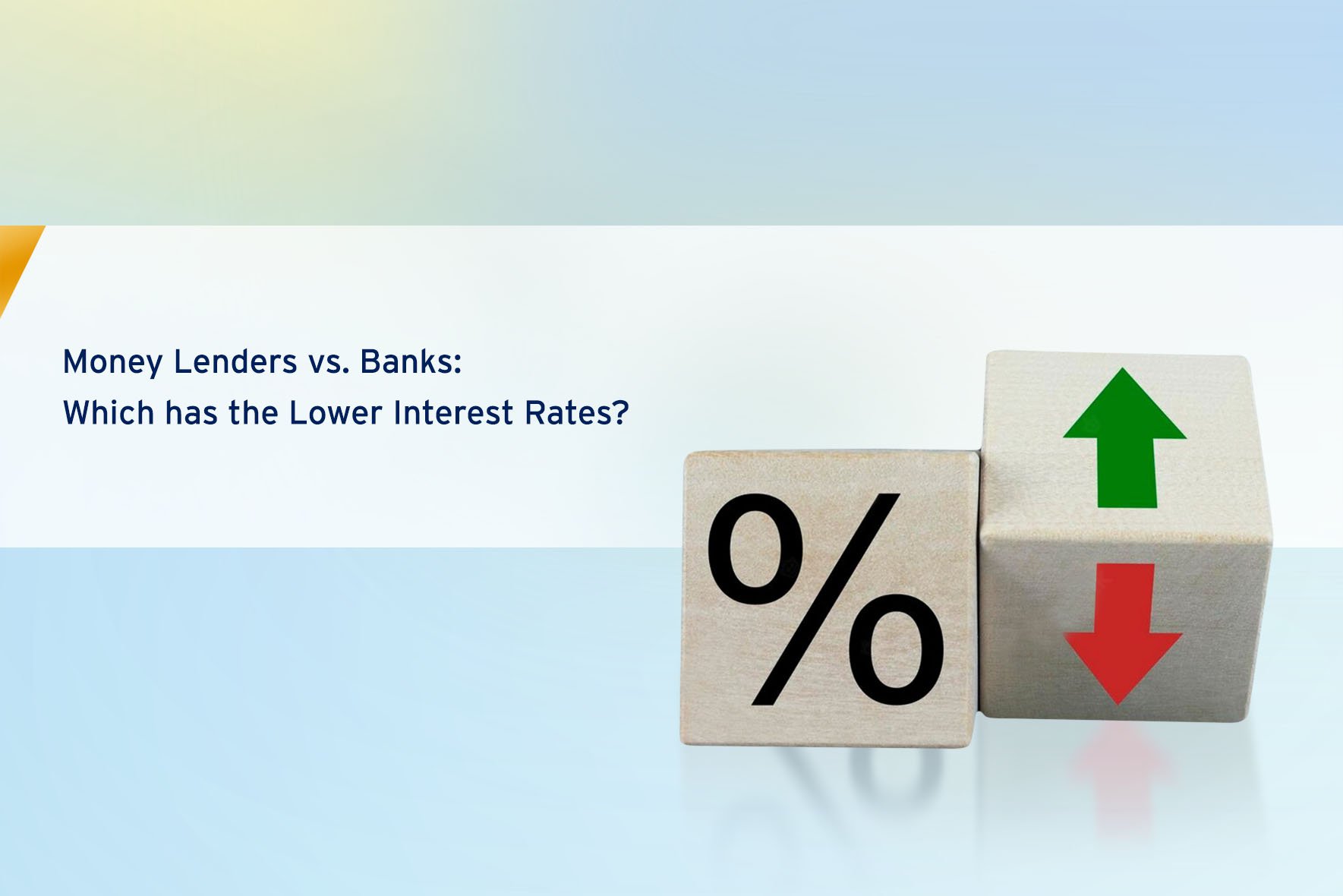
Money Lenders vs. Banks: Which Has the Lower Interest Rates?
Are you stuck between deciding on a loan from money lenders or banks? This article will guide you through your decision-making process. Banks and money lenders are both businesses that lend money, but they have different advantages and disadvantages.
Banks are regulated financial institutions that offer a variety of financial products, including loans, savings accounts, and checking accounts. They typically have lower interest rates than money lenders, but they may have stricter eligibility requirements.
Money lenders, on the other hand, are businesses that lend money to people who may not qualify for a loan from a bank.
They typically charge higher interest rates than banks, but they may be able to provide loans to people who have poor credit or who need money quickly.
Money Lenders: How they operate
Money lenders operate in a variety of ways. Some money lenders have physical storefronts, while others operate online.
They may also offer loans through payday lenders, or pawn shops.
When you apply for a loan from a money lender, you typically must provide some personal information, such as your name, address, and Bank Verification Number.
You will also need to provide information about your income and expenses.
The moneylender will then assess your risk and decide whether to approve your loan. If your loan is approved, you will be required to sign a promissory note, a legal document outlining the terms of the loan.
The terms of a loan from a money lender will vary, but they mostly include a high-interest rate and a short repayment period. You may also be required to pay a processing fee or other fees.
If you default on your loan, the money lender may be able to take legal action against you. This could include withholding your wages or seizing your property.
It is important to carefully consider the terms of a loan from a money lender before you agree to it.
Money lenders can be a good option for people who need money quickly, but they can also be expensive.
Some of the key features of loans from money lenders include.
- High interest rates
- Short repayment terms
- High fees
- Risk of default
It is important to weigh the risks and benefits before getting a loan from a money lender.
Banks vs Money Lenders
When considering borrowing options, it's important to assess your specific needs, financial situation, and preferences.
Banks provide a wider range of services and may offer lower interest rates, but they also have stricter requirements and a more formal lending process.
Money lenders, especially informal lenders, may be more accessible and flexible, but they may charge higher interest rates and have less regulatory oversight.
Here are some key differences between banks and money lenders:
● Regulation
Banks are highly regulated financial institutions that are governed by banking laws and regulatory authorities such as central banks.
They are subject to strict compliance requirements and oversight to ensure financial stability, consumer protection, and adherence to lending guidelines.
Money lenders, especially informal or non-bank lenders, may operate with fewer regulations and may not be subject to the same level of oversight.
● Range of services
While banks offer a wide range of financial services beyond lending, including savings accounts, current accounts, investment products, and other banking services, money lenders primarily focus on lending activities and may have more limited offerings compared to banks.
● Interest rates and fees
Compared to money lenders, banks generally offer lower interest rates.
Banks have access to various funding sources, such as customer deposits and interbank borrowing, which typically have lower costs.
Money lenders, especially informal lenders, may charge higher interest rates to compensate for the increased risk they take by lending to borrowers with limited creditworthiness or collateral.
● Borrower requirements
Banks typically have more stringent requirements for loan approval. Before extending credit, they assess the borrower's creditworthiness, income stability, collateral, and other factors.
Banks may also require extensive documentation and have a longer approval process.
Money lenders, especially non-bank or informal lenders may have more lenient eligibility criteria and a faster loan approval process.
● Collateral and security
Depending on their type and risk appetite, money lenders may be more flexible with collateral requirements or offer unsecured loans, especially for smaller amounts or short-term loans.
Banks, on the other hand, often require collateral or security for loans, especially for larger amounts. Collateral serves as a form of protection for the lender in case of default.
● Reputation and trust
Banks, especially well-established ones, often have a long-standing reputation and established trust in the market.
They provide a sense of security for customers due to their regulated status and adherence to industry standards.
Money lenders, particularly informal or non-bank lenders, may vary in terms of reputation, trust, and reliability. It is essential to research and carefully evaluate the reputation and credibility of money lenders before engaging with them.
Ultimately, the choice between banks and money lenders depends on factors such as your financial profile, the loan amount, the urgency of the loan, and your comfort level with the lender's credibility and terms.
Factors to consider when comparing money lenders and banks
In general, banks tend to offer lower interest rates compared to money lenders.
This is because banks are regulated financial institutions that typically have lower costs of funds and are subject to interest rate regulations imposed by central banks or other regulatory bodies.
Here are a few factors to consider when comparing interest rates between money lenders and banks:
1. Risk Assessment
Banks typically have more stringent requirements and conduct thorough risk assessments before lending money.
They consider factors such as creditworthiness, income stability, and collateral.
On the other hand, money lenders may be willing to lend to borrowers with higher risk profiles but may charge higher interest rates to compensate for the increased risk.
2. Cost of funds
Banks have access to various funding sources, including customer deposits and interbank borrowing, which tend to have lower costs compared to money lenders.
Money lenders may rely on their own capital or borrow at higher interest rates, which can contribute to higher interest charges on loans.
3. Borrower profile
Banks usually cater to a wider range of borrowers, including individuals, businesses, and institutions.
Money lenders may target specific customer segments or borrowers with limited access to traditional banking services. The borrower's creditworthiness and risk profile can also influence the interest rates offered.
4. Interest rates
Banks typically have lower interest rates than money lenders. This means that you will pay less money in interest over the life of the loan if you get a loan from a bank.
5. Eligibility requirements
Banks have stricter eligibility requirements than money lenders. Borrowers may be more likely to be approved for a loan from a money lender if they have poor credit or if they need money quickly.
Comparison of banks and money lenders
In the financial landscape, banks and money lenders represent two distinct avenues for obtaining funds, each offering unique features that cater to different borrower needs. Let's compare these features between banks and money lenders.
Interest rates
Rates are a crucial factor that directly impacts the cost of borrowing. Banks typically offer lower interest rates compared to money lenders. This is because banks are more established institutions with a stable source of funds, allowing them to extend loans at more favourable rates. On the other hand, money lenders, being smaller entities or individuals, often charge higher interest rates to compensate for the higher risk they bear.
Eligibility requirements
These are another differentiating factor. Banks usually have stricter criteria when evaluating loan applicants. They typically demand a good credit history, stable income, and collateral to minimize their risk exposure. Money lenders, being less formal and adaptable, may have less strict eligibility requirements, making it easier for some borrowers with less-than-perfect credit or without collateral to access loans.
Loan amounts
Loan amounts vary significantly between banks and money lenders. Banks are capable of offering larger loan amounts due to their extensive financial resources and risk assessment capabilities. Conversely, money lenders may provide smaller loan amounts since they operate on a smaller scale and might be limited by their own available funds.
Loan terms
This refers to the duration of the loan repayment period. Banks usually offer longer loan terms, allowing borrowers more time to repay their debts, which can be advantageous for larger loans. Money lenders, who often deal with smaller loan amounts, tend to offer shorter loan terms, which can be more suitable for borrowers seeking quicker repayment options.
Fees
This is an essential aspect to consider when evaluating borrowing options. Generally, banks tend to charge lower fees compared to money lenders. Banks have more standardized fee structures and are subject to stricter regulations, which helps keep their fees relatively lower. Money lenders, operating with more flexibility, may impose higher fees, which could add to the overall cost of borrowing.
Government regulation
The level of government regulation sets banks and money lenders apart. Banks are heavily regulated by financial authorities, ensuring compliance with various laws and safeguarding consumer interests. Money lenders, on the other hand, may not be subject to the same level of regulation, which can result in fewer consumer protections and potentially riskier borrowing experiences.
In conclusion, both banks and money lenders offer different advantages and disadvantages, making them suitable for different financial needs and circumstances. It's essential for borrowers to carefully evaluate their options, considering factors like interest rates, eligibility requirements, loan amounts, terms, fees, and regulatory oversight to make an informed decision that aligns with their specific borrowing requirements.
Choosing the right lender
The best type of lender for you will depend on your individual circumstances. If you have good credit and need a large loan, a bank may be a good option. If you have bad credit or need a smaller loan, a money lender may be a better choice.
It is important to shop around and compare different lenders before you choose one. You should also read the fine print carefully before you sign any loan agreements.
Visit nairaCompare to compare loan providers and select the one that’s best for you!
About Author





